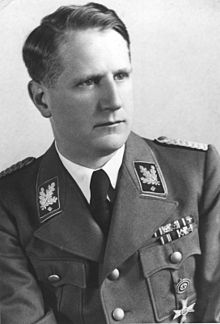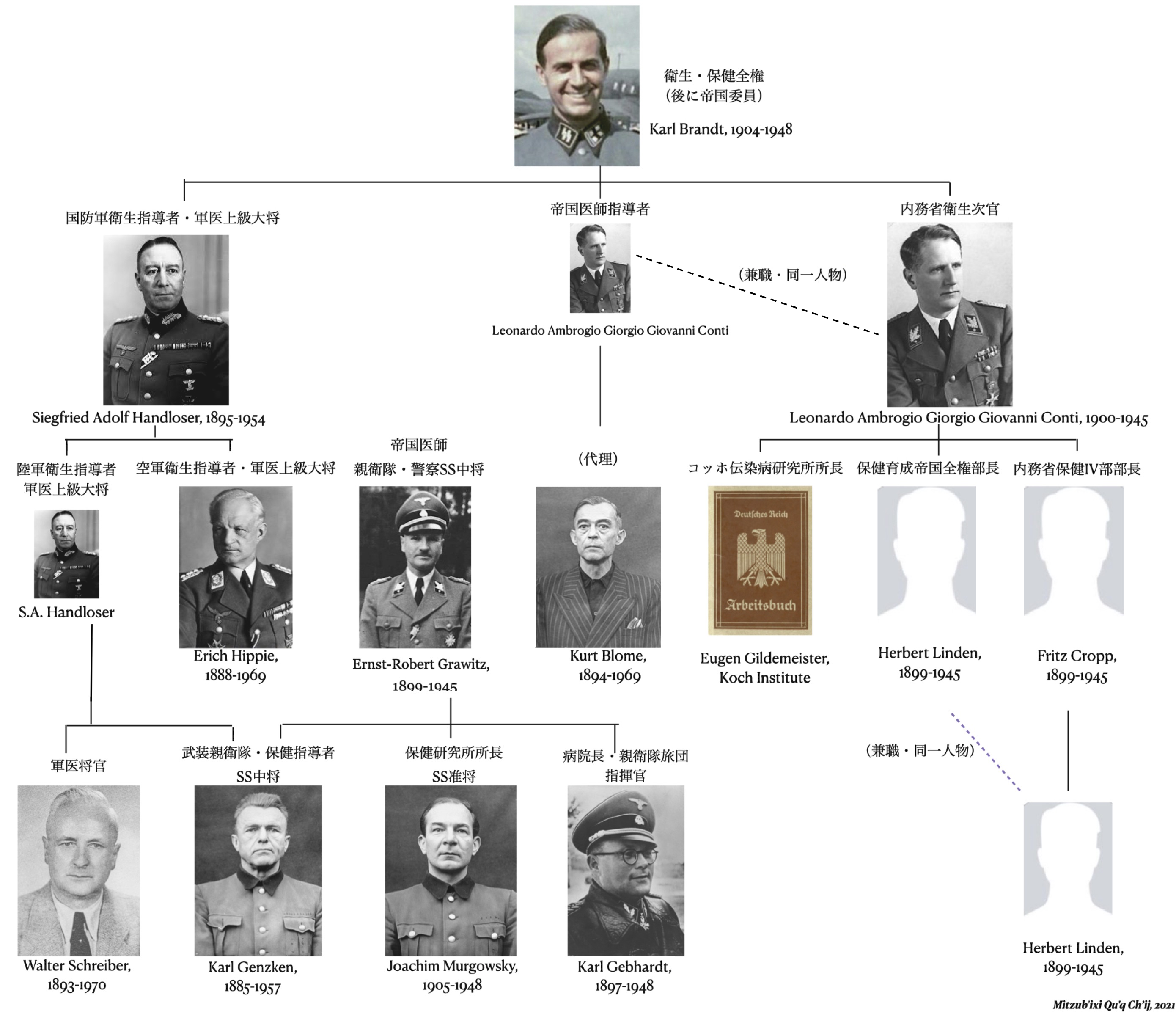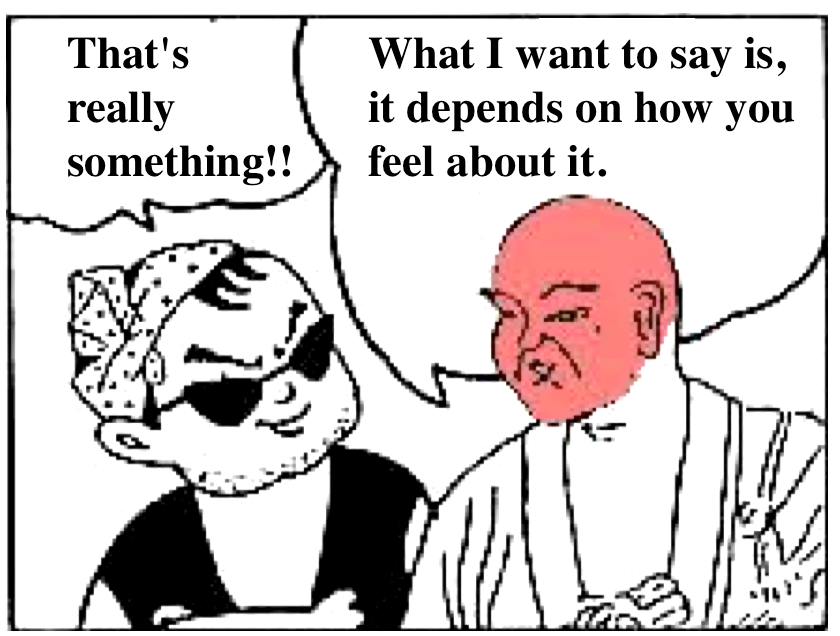初代帝国医師リーダーのゲルハルト・アーグナーとその後任者レオナルド・コンティについて


| Gerhard
Wagner (18
August 1888 in Neu-Heiduk, Prussian Silesia, now in Poland – 25 March
1939 in Munich) was the first Reich Doctors' Leader (Reichsärzteführer)
in the time of Nazi Germany. |
ゲルハルト・ワグナー(1888年8月18日プロイセン領シレジア地方
ノイハイドゥク、現ポーランド -
1939年3月25日ミュンヘン)は、ナチスドイツ時代の最初の帝国医師団長(Reichsärzteführer)であった。 |
| Pre-Nazism Born a surgery professor's son, he studied medicine in Munich and served as a doctor at the front in World War I (1914–1918). Among other things, he was awarded the Iron Cross, first class. From 1919, Wagner ran his own medical practice in Munich, while also being a member of two Freikorps between 1921 and 1923, von Epp and Oberland. Just because of his Upper Silesian origins, Wagner stayed on (till 1924) as leader of the Upper Silesia German Community Associations (Deutschtumsverbände Oberschlesiens) and was chef of Munich´s division of the Loyal Upper Silesians („Verbände heimattreuer Oberschlesier"). In May 1929, he switched to the NSDAP. |
ナチズム以前 外科教授の息子として生まれ、ミュンヘンで医学を学び、第一次世界大戦(1914-1918)には前線で医師として従軍した。第一次世界大戦(1914- 1918)では、医師として戦地に赴き、鉄十字勲章を授与されるなど、活躍した。 1919年からミュンヘンで診療所を経営する一方、1921年から1923年にかけてフォンエップ、オーベルラントという2つのフリーコルプのメンバーで もあった。上シレジア出身のため、ワーグナーは(1924年まで)上シレジア・ドイツ共同体協会(Deutschtumsverbände Oberschlesiens)のリーダーとして留まり、ミュンヘンの忠誠上シレジア人の部門(Verbände heimattreuer Oberschlesier)のシェフを務めていた。1929年5月、彼はNSDAPに転向した。 |
| 1930s Wagner was co-founder and as of 1932 leader of the National Socialist German Doctors' League, and also functioned from 1933 as a member of the Palatinate Landtag. A year later, in 1934, Wagner was ordered to the position of Reich Doctors' Leader. Moreover, he was "The Führer's Commissioner for National Health". By 1933, he had already become leader of the Main Office for National Health, and in 1936 came his appointment as that office's Main Service Leader (Hauptdienstleiter). In December 1935, Wagner became leader of the Reichsärztekammer (Physicians' Chamber). At the 1936 Nuremberg Rally, he discussed the racial laws. As was typical of Nazi propaganda at this time, this was more in terms of the pure and growing race than the evil of the Jews.[1] A shift in his political career came in 1937 when he was promoted to SA Obergruppenführer. Meanwhile, he was also commissioner for collegiate issues on Rudolf Hess's staff. Wagner died quite young, at only 50. The cause of his sudden death is to this day unknown. His successor was Leonardo Conti. |
1930s ワーグナーは、国家社会主義ドイツ医師連盟の共同設立者であり、1932年時点のリーダーであった。また、1933年からプファルツ州議会議員として活動 した。1年後の1934年、ワーグナーは帝国医師団長の地位を命じられた。さらに彼は、「総統の国民保健委員」でもあった。1933年にはすでに国民保健 本部の長となり、1936年には同本部の主計長(Hauptdienstleiter)に任命された。 1935年12月、ワーグナーは帝国医師会(Reichsärztekammer)の指導者となった。1936年のニュルンベルク集会で、彼は人種法につ いて議論した。この時期のナチスのプロパガンダの典型であったように、これはユダヤ人の悪というよりも純粋で成長する人種という観点であった[1]。 彼の政治的キャリアに変化が訪れたのは1937年にSA親衛隊上級大将に昇進した時であった。その一方で、ルドルフ・ヘスのスタッフとして大学問題のコ ミッショナーも務めていた。 ワーグナーはわずか50歳という若さで亡くなった。突然の死因は今日に至るまで不明である。後任はレオナルド・コンティだった。 |
| Gerhard
Wagner
war Sohn des Arztes Wilhelm Wagner. Er studierte Medizin in München und
diente 1914–1918 als Feldhilfsarzt an der Ostfront (Erster Weltkrieg).
Er erhielt das Eiserne Kreuz 1. Klasse. Nach dem Krieg war er Mitglied
des Freikorps Epp.[1] Er war nach Kriegsende bis 1920 Assistenzarzt an
der Münchener Frauenklinik und betrieb danach in München eine eigene
Arztpraxis. Gleichzeitig war er 1921–1923 Mitglied des Freikorps
Oberland. Bis 1924 war Wagner Leiter der Deutschtumsverbände
Oberschlesiens. Er leitete den Landesverband Bayern der vereinigten
Verbände heimattreuer Oberschlesier. Am 17. Mai 1929 trat Wagner in die Nationalsozialistische Deutsche Arbeiterpartei (Mitgliedsnummer 129.008) ein. Er war im selben Jahr Mitbegründer und ab 1932 Leiter des Nationalsozialistischen Deutschen Ärztebundes (NSDÄB). Im März 1933 wurde er Reichskommissar für die gleichgeschalteten ärztlichen Spitzenverbände. Am 21. März unterstellten sich der Deutsche Ärztevereinsbund und der Hartmannbund dem Reichskommissar.[2] Er leitete ab August 1933 die neu gegründete Kassenärztliche Vereinigung und wurde Vertrauensmann für Volksgesundheit beim Stab des Stellvertreters des Führers. 1934 wurde er zum Leiter des neu gegründeten Hauptamtes für Volksgesundheit ernannt, wo er 1935 Hauptamtsleiter und 1936 Hauptdienstleister wurde. Seit 1934 war Wagner darüber hinaus Beauftragter für Hochschulfragen im Stab von Rudolf Heß, dessen Hausarzt er war.[3] Er saß in der Hochschulkommission der NSDAP. Im Dezember 1935 wurde Wagner außerdem Leiter der Reichsärztekammer und 1936 Reichsärzteführer der NSDAP.[1] Er leitete das Sanitätswesen auf dem Reichsparteitag und gehörte der Reichsarbeitskammer an. Zudem war er Mitglied des Sachverständigenbeirats für Bevölkerungs- und Rassenpolitik des Reichsministeriums des Inneren, ab Januar 1936 des Reichsausschusses zum Schutze des deutschen Blutes und ab 1937 des Arbeitskreises für Gesundheitsführung des Deutschen Volkes. Von der Reichstagswahl November 1933 bis zu seinem Tode war Wagner Abgeordneter im Reichstag (Zeit des Nationalsozialismus). Seit 1929 Mitglied der Sturmabteilung (SA), wurde er 1937 zum SA-Sanitätsobergruppenführer befördert. Wagner starb im Alter von 50 Jahren an Krebs. Sein Nachfolger als Reichsärzteführer wurde der Berliner Stadtmedizinalrat Leonardo Conti. Wagner war mitverantwortlich für Krankenmorde in der Zeit des Nationalsozialismus und Zwangssterilisationen von Juden und Behinderten. Auf dem Reichsparteitag von 1935 zeigte er sich als entschiedener Befürworter der Nürnberger Gesetze. |
ゲ
ルハルト・ワーグナーは、医師ヴィルヘルム・ワーグナーの息子である。ミュンヘンで医学を学び、1914年から1918年まで東部戦線(第一次世界大戦)
で補助医として従軍した。鉄十字章1級を授与される。終戦後はフリーコルプス・エップに所属していた[1]。終戦後、1920年までミュンヘン婦人科診療
所の助手を務め、その後ミュンヘンで開業した。同時に、1921年から1923年にかけては、オーベルラント自由騎士団に所属していた。1924年まで、
ワーグナーはオーバーシレジアのドイツ協会の代表を務めていた。バイエルン州の上部シレジア人連合協会を率いていた。 1929年5月17日、ワーグナーは国家社会主義ドイツ労働者党に入党した(党員番号129,008)。同年、国家社会主義ドイツ医学協会(NSDÄB) の共同設立者となり、1932年からは代表を務めている。1933年3月、ナチス政権下の中央医師会帝国委員に就任した。3月21日、ドイツ医師会とハル トマンブンドは帝国委員に従属した[2]。 1933年8月からは、新たに設立された法定保険医協会を率い、総統代理のスタッフとして公衆衛生担当コンフィダントとなった。1934年、新設された公 衆衛生本部の本部長に任命され、1935年には本部長、1936年には本務部長となった。また、1934年からは、ルドルフ・ヘスの家庭医として、高等教 育問題担当の委員を務めた[3]。1935年12月、ワーグナーは帝国医師会会長となり、1936年にはNSDAPの帝国医師団長となった[1]。 彼は帝国党大会での医療サービスの責任者で、帝国労働会議のメンバーであった。彼はまた、1936年1月から帝国内務省の人口・人種政策専門諮問委員会、 ドイツ血液保護委員会、1937年からドイツ国民の健康指導に関する作業部会のメンバーでもあった。 1933年11月の帝国議会選挙から亡くなるまで、ワーグナーは帝国議会議員を務めていた(国家社会主義時代)。1929年からSAに所属し、1937年 にSA-Sanitätsobergruppenführerに昇格した。ワーグナーは50歳の若さで癌で亡くなった。帝国軍総統の後任は、ベルリン市医 師会評議員のレオナルド・コンティだった。ワーグナーは、国家社会主義時代の病人殺害、ユダヤ人と障害者の強制不妊手術に共同して責任を負っていた。 1935年の帝国党大会では、ニュルンベルク法の強固な支持者であることを示した。 |
| Leonardo
Conti (German pronunciation: [ˈleːonaʁdo ˈkɔnti]; 24 August 1900 – 6
October 1945) was the Reich Health Leader in Nazi Germany. The killing
of many Germans who were of "unsound mind" is attributed to his
leadership.[1] Conti was born to a Swiss Italian father, Silvio, and a German mother, Nanna Pauli; his mother later became the Reich Midwifery Leader in Nazi Germany. Conti later studied medicine at the Humboldt University of Berlin and the University of Erlangen–Nuremberg. He became active in the völkisch movement and the Viking League, and co-founded an antisemitic paper called Kampfbund ("Struggle league"). He took part in the Kapp Putsch in 1920. From 1923 he was a member of the Sturmabteilung (SA), becoming their first physician; one of his patients was Horst Wessel, who eventually became a martyr of the Nazi Party. In 1925, he promoted "Über Weichteilplastik im Gesicht", a book about facial plastic surgery. In 1927 he left his usual activities and started organizing the National Socialist German Doctors' League. |
レオナルド・コンティ(ドイツ語発音:[ˈleːʁ,
1900年8月24日 -
1945年10月6日)は、ナチスドイツの帝国保健指導官。「不健康な心」をもった多くのドイツ人を殺害したのは、彼の指導によるものとされる[1]。 コンティは、スイス系イタリア人の父シルヴィオとドイツ人の母ナンナ・パウリとの間に生まれた。母は後にナチス・ドイツの帝国助産師長となる。 母は後にナチスドイツの帝国助産師長となった。その後、コンティはベルリンのフンボルト大学とエアランゲン=ニュルンベルク大学で医学を学んだ。ヴェル キッシュ運動やヴァイキング同盟で活動し、「カンプフブント」(「闘争同盟」)という反ユダヤ主義的な新聞を共同創刊した。1920年のKapp Putschに参加。1923年からはSAに所属し、最初の医師となった。患者の一人はホルスト・ヴェッセルで、彼は最終的にナチスの殉教者となった。 1925年には、顔の整形手術に関する本『Über Weichteilplastik im Gesicht』を出版した。1927年、彼はそれまでの活動を離れ、国家社会主義ドイツ医師連盟を組織するようになった。 |
| Nazi doctor He joined the SS and, as an "old fighter" of the party, he was appointed by Hermann Göring to the Prussian State Council. Conti held the posts and titles of Head of the Reich Physicians' Chamber (Reichsärztekammer), Leader of the NSDÄB, and Leader of the Main Office for the People's Health. In 1937 he was elected to the presidency of the FIMS, the International Federation of Sports Medicine.[2] The FIMS today considers this to have been "a black page' in their history. In 1939, Conti was appointed Reich Health Leader and State Secretary in the Interior Ministry. On 1 July 1941, as the Chief of Health in the Reich, he obtained the classification of Pervitin (see History and culture of substituted amphetamines) among the products defined by Reich law on opiates. It condemns the private use of Pervitin, but does not call into question its use for military purposes.[3] In 1944, he was promoted to SS-Obergruppenführer (lieutenant general). |
ナチス・ドクター 親衛隊に入隊し、党の「古参闘士」としてヘルマン・ゲーリングからプロイセン州議会議員に任命される。コンティは、帝国医師会議 (Reichsärztekammer)議長、NSDÄB議長、人民衛生局長のポストと肩書きを歴任している。1937年、彼は国際スポーツ医学会 (FIMS)の会長に選出された[2]。FIMSは今日、これを彼らの歴史における「黒いページ」であったとみなしている。1939年、コンティは内務省 の帝国保健指導者兼国務長官に任命された。1941年7月1日、彼は帝国保健部長として、アヘンに関する帝国法で定められた製品の中にペルビチン(置換ア ンフェタミンの歴史と文化を参照)を分類することを得た。この法律はペルビチンの私的使用を非難しているが、軍事目的での使用は問題にしていない[3] 1944年、彼はSS-Obergruppenführer (lieutenant general) に昇格した。 |
| Action T4 Leonardo Conti was a staunch promoter of a public medical administration strongly controlled by the Nazi state. Under his leadership, local health offices were further expanded to allow for a genetic control and selection of the population in order to remove "weak" elements for the improvement of the German race, a doctrine known as eugenics. The various programmes were the basis for "racial hygiene" a lethal part of the Nazi philosophy. Accordingly, he was co-responsible for the forced sterilization program, the racially motivated forced pregnancy interruptions, and ultimately the Action T4 program.[4] It is also undisputed that Conti participated in human experiments.[4] The Nazi involuntary euthanasia program involved the planned murder of mentally and physically impaired patients and started in September 1939 when the policy was approved by Hitler in a personal decree. He approved the euthanasia of a young disabled boy, Gerhard Kretschmar, at the request of his father, but approval was quickly extended to other disabled children, and then disabled adults. The approval of three doctors was needed for killing of any individual to proceed. The killings were conducted in many hospitals and asylums such as Hadamar Euthanasia Centre by a variety of methods, including enforced starvation, injection of lethal drugs, and gassing using carbon monoxide. Patients were carefully deceived to believe that they were simply taking a shower so as to entice them into the gas chamber, then locked in and asphyxiated through carbon monoxide poisoning. Although public protests led by Bishop Galen and others forced the policy to be officially suspended in 1941, it continued unofficially until the end of the war. The program constituted the basis for the later programme of mass murder known as the Holocaust of Jews, Poles, Gypsies as well as other Slavs, and Russian POWs in camps such as Treblinka, Sobibor, Belzec, Chelmno, Auschwitz-Birkenau, and Majdanek. Gassing with Zyklon B was used mainly at Auschwitz and Majdanek with over 1 million victims, and Carbon monoxide at Treblinka, Sobibor, Belzec and Chelmno, the main extermination camps. Such mass murder followed the earlier murders through gunfire by the Einsatzgruppen death squads. Many of the SS staff involved in the later murders developed their lethal methods during the Action T4 programme, overseen by Conti. Victims were deceived in the same way as in Action T4, using very elaborate means to convince them that no harm was intended to them. Conti was also involved in the forensic investigation into the Katyn massacre, and received a detailed report, known as the Katyn Commission on the discovery from an international team of experts. |
アクションT4 レオナルド・コンティは、ナチス国家によって強力に管理される公的医療行政の熱心な推進者であった。彼の指導の下、地方の保健所はさらに拡張され、ドイツ 民族の改良のために「弱い」要素を取り除くために、遺伝子の制御と人口の選別を可能にするもので、優生学として知られる教義であった。このような様々なプ ログラムは、ナチス哲学の致命的な部分である「人種衛生」の基礎となるものであった。 したがって、彼は強制不妊化プログラム、人種的動機による強制妊娠中断、そして最終的にはアクションT4プログラムの共同責任者であった[4]。 また、コンティが人体実験に参加したことは議論の余地のない事実である[4]。 ナチスの非自発的安楽死プログラムは、精神的・身体的障害を持つ患者の計画的殺害を含み、1939年9月にヒトラーの個人勅令でその政策が承認されたとき に始まった。1939年9月、ヒトラーの個人的な命令で、障害を持つ少年ゲルハルト・クレッチマーの安楽死が承認され、その後、他の障害児、そして成人障 害者にも承認が拡大された。安楽死の実施には、3人の医師の承認が必要であった。殺害は、ハダマル安楽死センターのような多くの病院や精神病院で、強制的 な飢餓、致死薬の注射、一酸化炭素を使ったガス処理など、様々な方法で行われました。シャワーを浴びていると思わせてガス室に誘い込み、閉じ込めて一酸化 炭素中毒で窒息死させるという巧妙な手口である。1941年、ガレン司教を中心とする国民の抗議によって、この政策は公式に中止されたが、非公式に終戦ま で続けられた。 この計画は、後にホロコーストと呼ばれるユダヤ人、ポーランド人、ジプシー、その他のスラブ人、ロシア人捕虜をトレブリンカ、ソビボル、ベルゼク、チェル ムノ、アウシュビッツ=ビルケナウ、マジャネクなどの収容所で大量虐殺する計画の基礎となるものであった。アウシュビッツとマジュダネクでは主にチクロン Bによるガス処刑が行われ、100万人以上の犠牲者を出し、トレブリンカ、ソビボル、ベルゼク、チェルムノといった主要な絶滅収容所では一酸化炭素が使用 された。このような大量殺人は、それ以前のアインザッツグルッペン死の部隊による銃撃による殺人に続くものであった。後の殺人に関与したSS職員の多く は、コンティが監督した「アクションT4」計画の中で、その殺傷方法を開発したのです。犠牲者は「行動T4」と同じように騙され、非常に手の込んだ手段を 使って、自分に害が及んでいないと信じ込まされたのです。 コンティはカチンの虐殺の法医学的調査にも関与し、国際的な専門家チームから「カチン委員会」と呼ばれる発見の詳細な報告書を受け取りました。 |
| Post-war imprisonment and suicide On 19 May 1945, after Germany's surrender, Conti was imprisoned and would have been brought to the Doctors' Trial for his involvement in Action T4. However, on 6 October 1945, over a year before the trial began, Conti hanged himself in his Nuremberg cell.[5] |
戦後の投獄と自殺 1945年5月19日、ドイツ降伏後、コンティは投獄され、行動T4への関与のため医師団裁判にかけられるはずであった。しかし、裁判が始まる1年以上前 の1945年10月6日、コンティはニュルンベルクの独房で首を吊り自殺した[5]。 |
| https://en.wikipedia.org/wiki/Leonardo_Conti |
|
+++
Links
- ︎▶︎︎▶︎▶︎︎▶︎▶︎︎▶︎▶︎︎▶︎︎
リンク
- ▶︎▶︎︎▶︎▶︎︎▶︎▶︎︎▶︎▶︎
文献
その他の情報







 ☆
☆